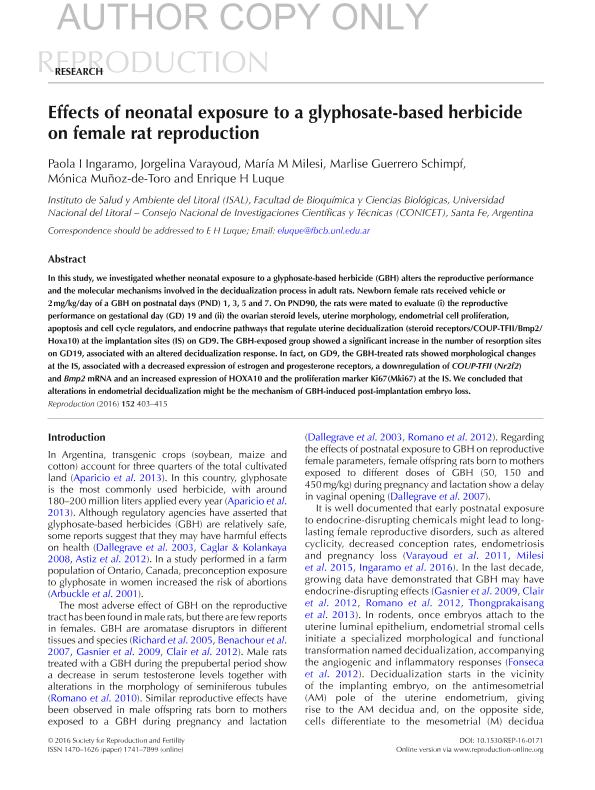Artículo
Effects of neonatal exposure to a glyphosate-based herbicide on female rat reproduction
Ingaramo, Paola Inés ; Varayoud, Jorgelina Guadalupe
; Varayoud, Jorgelina Guadalupe ; Milesi, Maria Mercedes
; Milesi, Maria Mercedes ; Guerrero Schimpf, Marlise Luciana
; Guerrero Schimpf, Marlise Luciana ; Muñoz de Toro, Monica Milagros; Luque, Enrique Hugo
; Muñoz de Toro, Monica Milagros; Luque, Enrique Hugo
 ; Varayoud, Jorgelina Guadalupe
; Varayoud, Jorgelina Guadalupe ; Milesi, Maria Mercedes
; Milesi, Maria Mercedes ; Guerrero Schimpf, Marlise Luciana
; Guerrero Schimpf, Marlise Luciana ; Muñoz de Toro, Monica Milagros; Luque, Enrique Hugo
; Muñoz de Toro, Monica Milagros; Luque, Enrique Hugo
Fecha de publicación:
11/2016
Editorial:
BioScientifica
Revista:
Reproduction
ISSN:
1470-1626
Idioma:
Inglés
Tipo de recurso:
Artículo publicado
Clasificación temática:
Resumen
In this study, we investigated whether neonatal exposure to a glyphosate-based herbicide (GBH) alters the reproductive performance and the molecular mechanisms involved in the decidualization process in adult rats. Newborn female rats received vehicle or 2 mg/kg/day of a GBH on postnatal days (PND) 1, 3, 5 and 7. On PND90, the rats were mated to evaluate (i) the reproductive performance on gestational day (GD) 19 and (ii) the ovarian steroid levels, uterine morphology, endometrial cell proliferation, apoptosis and cell cycle regulators, and endocrine pathways that regulate uterine decidualization (steroid receptors/COUP-TFII/Bmp2/Hoxa10) at the implantation sites (IS) on GD9. The GBH-exposed group showed a significant increase in the number of resorption sites on GD19, associated with an altered decidualization response. In fact, on GD9, the GBH-treated rats showed morphological changes at the IS, associated with a decreased expression of estrogen and progesterone receptors, a downregulation of COUP-TFII (Nr2f2) and Bmp2 mRNA and an increased expression of HOXA10 and the proliferation marker Ki67(Mki67) at the IS. We concluded that alterations in endometrial decidualization might be the mechanism of GBH-induced post-implantation embryo loss.
Archivos asociados
Licencia
Identificadores
Colecciones
Articulos(CCT - SANTA FE)
Articulos de CTRO.CIENTIFICO TECNOL.CONICET - SANTA FE
Articulos de CTRO.CIENTIFICO TECNOL.CONICET - SANTA FE
Articulos(ISAL)
Articulos de INSTITUTO DE SALUD Y AMBIENTE DEL LITORAL
Articulos de INSTITUTO DE SALUD Y AMBIENTE DEL LITORAL
Citación
Ingaramo, Paola Inés; Varayoud, Jorgelina Guadalupe; Milesi, Maria Mercedes; Guerrero Schimpf, Marlise Luciana; Muñoz de Toro, Monica Milagros; et al.; Effects of neonatal exposure to a glyphosate-based herbicide on female rat reproduction; BioScientifica; Reproduction; 152; 5; 11-2016; 403-415
Compartir
Altmétricas



